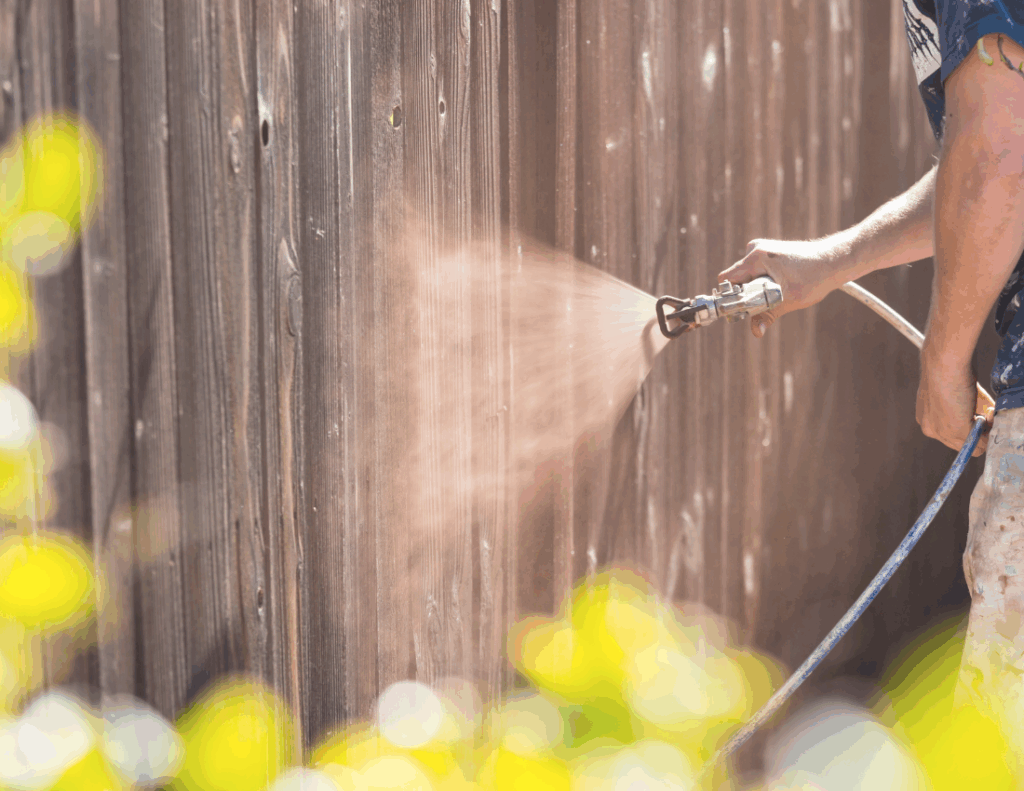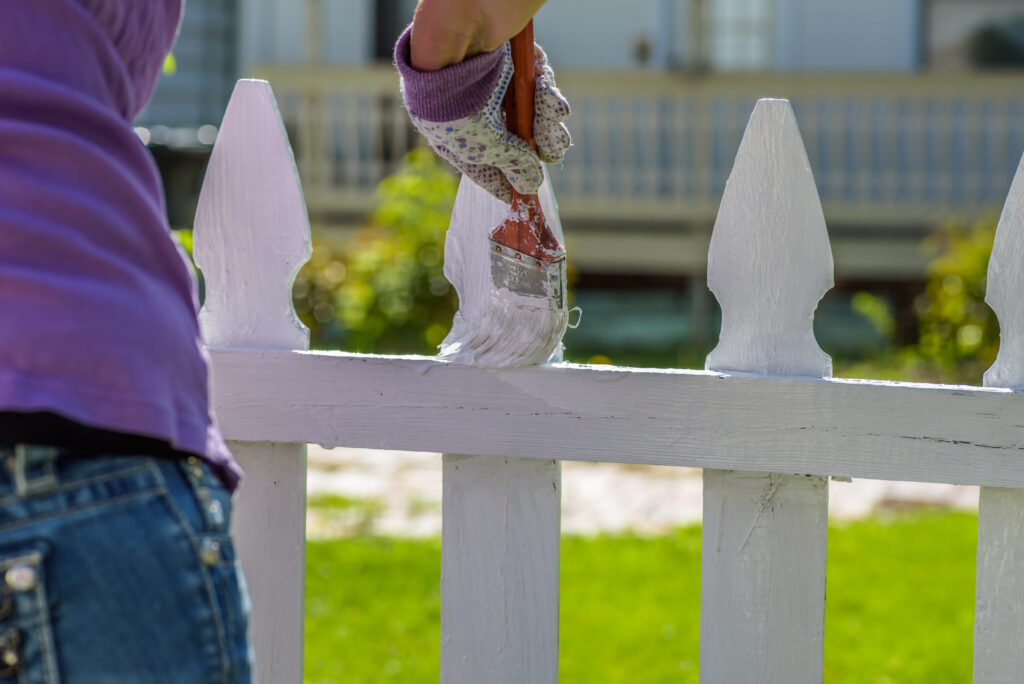If you’ve ever stood in your backyard staring at your fence and wondered, should I paint or stain my fence? — you’re not alone. Homeowners in Weston, CT ask this all the time. Fences deal with rain, snow, sun, and shifting temperatures, so the choice you make impacts not only how your fence looks but also how long it lasts.
Both options have clear benefits, and your decision comes down to the type of wood, the look you’re after, and how much upkeep you’re comfortable with. We’ve seen how the right finish can extend the life of wood, improve curb appeal, and cut down on headaches with maintenance.
Key Takeaways:
- Painting offers endless color choices, while stain highlights the natural wood grain.
- Stain typically needs reapplication every 3–4 years, paint about every 5–6 years.
- Water-based paint resists yellowing; oil-based paint provides a durable finish.
- Stain requires less prep, while paint often needs sanding and primer before recoating.
- Moisture and climate in Weston, CT play a major role in fence finish longevity.

Paint or Stain My Fence: What to Think About
Before jumping into the details, let’s set the stage. Paint gives you endless color choices and hides imperfections, while stain highlights the natural wood grain and offers deep protection. Both act as barriers against moisture, mold, and mildew, which is critical in a climate like Weston’s where damp conditions can take a toll on lumber.
Now let’s break it down section by section.
How Long Each Finish Lasts
When clients ask, how often do I need to redo this? the answer depends on whether you go with paint or stain.
- Stain usually needs refreshing every 3 to 4 years. It soaks into the wood, creating a protective shield against rain, water, and climate changes.
- Paint can last 5 to 6 years before it starts showing wear. But when paint ages, it tends to peel, crack, or blister.
Stain fades more naturally, while paint fails more visibly. If you prefer not to deal with scraping and sanding peeling layers, stain might feel like less of a headache.
Color and Aesthetics
Paint gives you freedom. Want your fence to match your shutters or trim? With today’s wide range of water-based and oil-based paints, you can choose a finish that balances durability with appearance. Water-based paints are easier to clean up, resist yellowing over time, and are often more flexible in shifting climates, while oil-based paints deliver a smooth, durable surface that can stand up well to heavy wear.
Stain, however, enhances the wood grain. Semi-transparent stains add pigment but still show texture, while solid stains look closer to paint but allow the fence to breathe. If you’ve invested in a wood fence with beautiful cedar or redwood, stain can bring out its natural beauty instead of covering it.
And yes, brands like Behr make both options in different finishes and sizes, often by the gallon, so you’ll have plenty of choices whether you’re aiming for a natural look or a bold design.
Maintenance and Wear Over Time
Upkeep is where the differences really show.
- A painted fence needs more prep when it’s time to reapply. Old paint must be sanded, flaking layers removed, and in many cases, you’ll need fresh primer coats before applying a new latex or oil-based finish.
- With stain, you typically only need a solid pressure washing to clean the surface before applying a new coat. Because stain penetrates the wood instead of sitting on top, it can’t peel.
Fences in Weston often battle with moisture, which leads to mold, mildew, and early wear. Keeping up with maintenance is part of protecting your investment, whether it’s a picket fence, wooden fence, or full fence installation.
Which Is Easier to Apply?
While we don’t recommend tackling this project on your own, it’s worth knowing the process.
- Stain is generally easier to work with because the wood absorbs it evenly. Even if you use a sprayer, you won’t see as many drips or uneven marks.
- Paint requires more prep and smoother surfaces. If the wood is rough, you’ll need sandpaper to create a clean base.
And don’t forget the weather factor: Stain needs a few dry days without rain and a temperature above 50°F. Paint is a bit more forgiving when it comes to timing.
Protecting Against Moisture and Climate in Weston, CT
In our area, fences face humid summers, wet autumns, and icy winters. Without protection, wood absorbs water, leading to swelling, cracking, and even rot.
- Sealants in stain help keep moisture out while allowing the lumber to breathe.
- Paint forms a solid barrier, but once it cracks, water can seep underneath and cause damage.
We’ve seen fences where mildew and mold spread quickly under old layers of paint. Stain’s breathable quality makes it more resilient to Weston’s shifts in climate.
Cost: Does One Save You More?
At first glance, paint seems cheaper. But when you factor in the need for primer, more product coverage, and greater prep time, the costs even out.
Stain might cost more per gallon, but you’ll often need less of it, and it can last longer depending on the wood type and brand. The difference in maintenance and longevity usually matters more than the upfront price.
If you’re weighing budget, our paint calculator can give you a sense of how much material your fence will require, whether you choose paint or stain.
Considering the Wood Type
Not all wood behaves the same way.
- Cedar doesn’t hold paint well and actually lasts longer with stain.
- Pressure-treated lumber can handle either paint or stain, but it needs to dry fully before treatment.
- Rough-cut or exterior wood often looks best with an oil-based stain, since the texture gives it character.
If you’ve inherited a wood fence that was already painted, moving back to stain will require extra prep. In those cases, paint may be the simpler path forward.
Fence and Deck Connections
While fences are the focus, the same principles apply to decks, pergolas, and other exterior wood structures. As trusted deck painters in Weston, CT, we often help homeowners choose whether to paint or stain their deck based on how they use the space, the type of lumber, and how much maintenance they want in the future.
If your fence and deck are both due for updates, choosing the same finish can help tie your outdoor spaces together. A painted deck paired with a stained fence might clash, while a consistent finish creates cohesion.
And if you’re wondering about application methods, you might enjoy our comparison of roller painting vs spray painting, which explains how different techniques affect coverage and finish.
Final Thoughts: Paint or Stain My Fence in Weston, CT?
When you’re asking, should I paint or stain my fence?, the answer depends on your priorities.
- Want endless color options and don’t mind sanding and scraping every few years? Paint may be your pick.
- Prefer a natural look that shows the wood grain and requires less prep for reapplication? Stain is the winner.
Both approaches protect against moisture, extend longevity, and keep fences looking sharp in Weston’s changing climate. The real difference lies in aesthetics, upkeep, and how your fences or deck fit into the rest of your outdoor furniture and design.
If you’re ready to refresh your fence or deck in Weston, CT or the surrounding areas, call us at 203-429-4424 for a FREE estimate. Our experienced deck painters in Weston, CT will help you decide whether paint or stain is the right fit and deliver results built to last.


